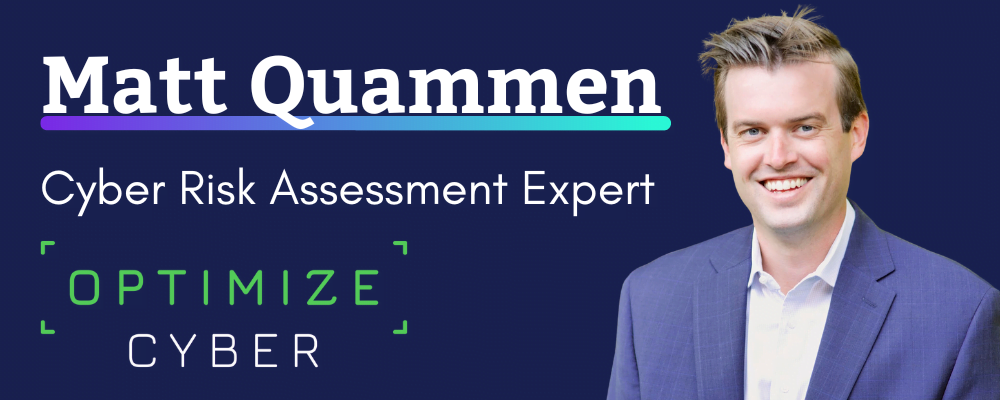In this article, Matt Quammen, Co-Founder and President at Optimize Cyber, delves into inside-out assessments for cyber risk.
Risk analysis and assessment remains one of the foundations of proper risk management. As cyber insurance carriers begin to require clients to conduct third-party risk assessments, selecting the right cyber risk assessment is more important than ever. Clients need a risk-based approach, independent results, strategies to reduce cyber risk with minimal spend and a focus on preventing financial losses first. So what do cyber insurance professionals need to consider when assessing cyber risk?
The Urgent Need for Risk-Based Strategies to Mitigate Unforeseen Threats – Why Inside-Out Assessments Are Key
Applying risk-based principles to cyber security assessment can aid organizations in comprehending that digital risks are interconnected with other hazards encountered by business leaders. The severity of threats can vary based on the situation, with some posing greater financial harm than others and differing in their controllability. As a result, it is critical to concentrate on risks that have either more significant or more controllable consequences while analyzing danger levels.
However, it is impossible for organizations to control every possible attack, emphasizing the importance of focusing on what they can manage. Inside-out risk assessments assist organizations in identifying the most critical risks to their operations and those within their sphere of influence that they can genuinely mitigate. By adopting an inside-out approach, companies can detect previously unnoticed risks, resulting in more comprehensive risk management.
One significant constraint in protecting against every conceivable attack underscores the significance of strategies that focus only on what organizations can influence directly or modify rapidly upon identifying the escalation of threats that had not been adequately examined before. The abandonment of conventional methodological structures can lead to omissions that downplay the importance of certain threats and lead to ineffective safety posturing, as was previously considered impossible due to limited data availability and assumptions.
This approach can result in ineffective risk management and lead to delays and shocks for the end-users in unforeseen circumstances, undermining the norms, expectations, and trends of operational contexts. Therefore, it is crucial to adopt a more comprehensive outlook that considers all possible threat scenarios to prevent impacts and impositions that may be worse off than initially anticipated.
The Pros and Cons of Inside-Out Risk Assessments
An inside-out approach to risk assessment is beneficial for organizations because it allows for a more comprehensive, holistic approach to risk management. By starting with an internal analysis, organizations can identify potential risks that might have gone unnoticed in the past. This approach helps organizations develop more effective risk mitigation strategies and increase their overall risk awareness. As organizations continue to face complex and evolving risks, an inside-out approach to risk assessment will become even more important for effective risk management.
Holistic risk management
An inside-out approach allows organizations to view risk management holistically. By identifying and analyzing risks within the organization, organizations can better understand how those risks interact with external risks. This approach helps organizations prioritize risks and allocate resources effectively.
Improved risk identification
When organizations start with an inside-out approach, they can identify risks that are unique to their operations and industry. This approach helps organizations avoid overlooking risks that might not be apparent from an external perspective.
Increased risk awareness
With an inside-out approach to risk assessment, organizations can increase their risk awareness. By identifying risks within the organization, employees and stakeholders can become more aware of potential risks and take necessary precautions.
More effective risk mitigation
An inside-out approach can help organizations develop more effective risk mitigation strategies. By starting with an internal analysis, organizations can identify potential weaknesses and vulnerabilities in their operations. This approach helps organizations develop mitigation strategies that are tailored to their specific needs and risks.
Inside-Out Risk Assessments Offer Real-World Protection Against Financial Losses
Third-party risk assessments have traditionally centered on theoretical models, rather than practical controls used by real-world threat actors to steal money. Moreover, these assessments have given more importance to documenting controls than to identifying steps that organizations must take to counter potential attacks. This gap between theory and reality presents a significant risk to businesses, particularly as insurance carriers focus on the business processes in place at the time of binding.
To mitigate these risks, risk assessments must prioritize real-world prevention of attacks, particularly with regard to financial risks. Financial losses from cyber attacks typically fall into three categories: wire fraud or business email compromise, ransomware, and data breaches or third-party liabilities. Therefore, third-party risk assessments should concentrate on preventing financial damage to provide the most value.
In conclusion, it is essential to prioritize practical controls and prevention strategies to protect businesses against real-world threats. Third-party risk assessments must focus on identifying steps that organizations can take to counter potential attacks, particularly those that can cause financial losses. By doing so, companies can strengthen their risk management framework and ensure that they are well-equipped to deal with the evolving threat landscape of the digital age.
How to Reduce Cyber Risk Without Increasing Spending
Many organizations believe that meeting the security controls required by cyber insurance carriers will cost them a lot of money. However, there are many existing cybersecurity prevention strategies that can be utilized without incurring additional expenses. The key is to turn on and use the advanced security features already built into commercial business tools that are often not enabled by default.
One example is the security principle of Least Privilege, which is required or encouraged by many cyber insurance carriers. While many software solutions and service providers offer products to meet this requirement, they may not be necessary for Mid-Market and SMB organizations. These solutions can cause complexity, exacerbating the risk. Instead, organizations can establish default user permissions for common roles with minimal privileges and roll out the default user setting for staff who do not require administrative or elevated privileges.
A proper third-party risk assessment can help organizations identify areas where security can be enhanced without spending money. By following this strategy, businesses can stretch their security budget and maximize their cyber risk management efforts, meeting insurance requirements without incurring additional expenses.
Evidentiary Support for Cyber Claims
Errors or misrepresentations during the cyber claim application process have led to coverage denials in some instances. Therefore, accurately representing an organization’s current security controls and business processes is crucial to ensuring incident coverage.
A white paper published by Pepper Hamilton LLP states that a comprehensive risk assessment can serve as a factual basis for demonstrating that reasonable precautions were taken to prevent losses. This, in turn, increases the likelihood of claim coverage.
Partnering with a qualified cyber risk assessment company that offers indefinite support, such as Optimize Cyber, can provide evidentiary support in the event of an incident, bolstering the insured’s claim.
In summary, these are difficult times in the cyber risk industry and the turbulence is expected to continue. Applying the time-tested strategy of risk-based analysis can bring clarity to insureds. Following an inside-out strategy with a priority on financial risks can reduce losses. Focusing on security fundamentals along with evidentiary support of these practices brings more clarity and value. Together, we can solve the issues in the market and ensure a more resilient business community.
About the Author
Matt Quammen is the Co-Founder and President at Optimize Cyber leading go-to-market efforts to help cyber insurance brokers assist their clients in becoming better cyber risks. Matt has worked in technology and cyber security for over a decade, with broad experience in the cyber security space. He uses that knowledge to help clients prevent financial losses to real world cyber-attacks and to become better cyber risks so that organizations can acquire proper levels of cyber insurance coverage.
For more information regarding risk assessment best practices, visit www.rapidsecurityaudit.com.
To learn more about Optimize Cyber, visit www.optimizecyber.com.
Find out how you could become a Certified Cyber Insurance Specialist (CCIS) here.








